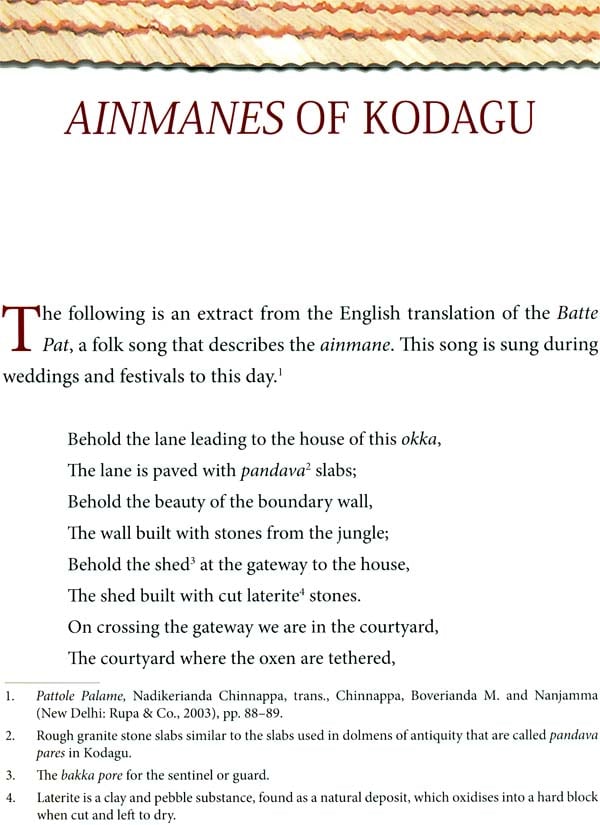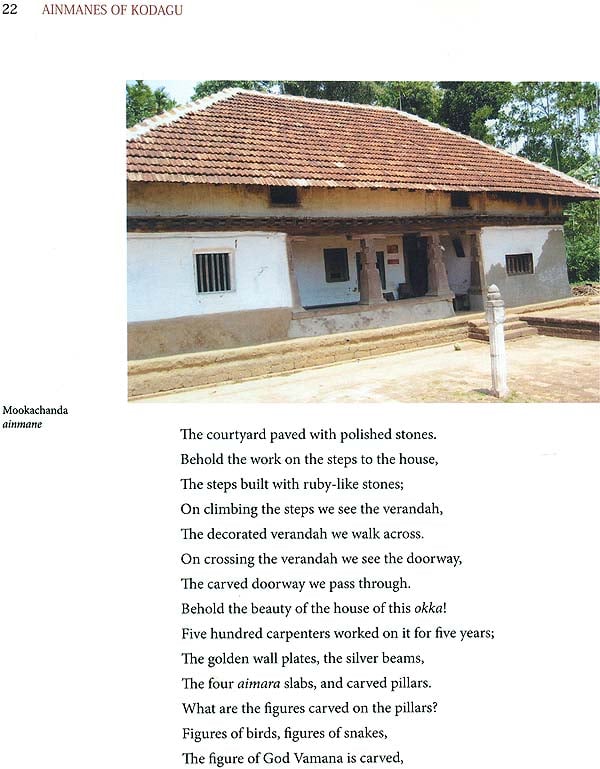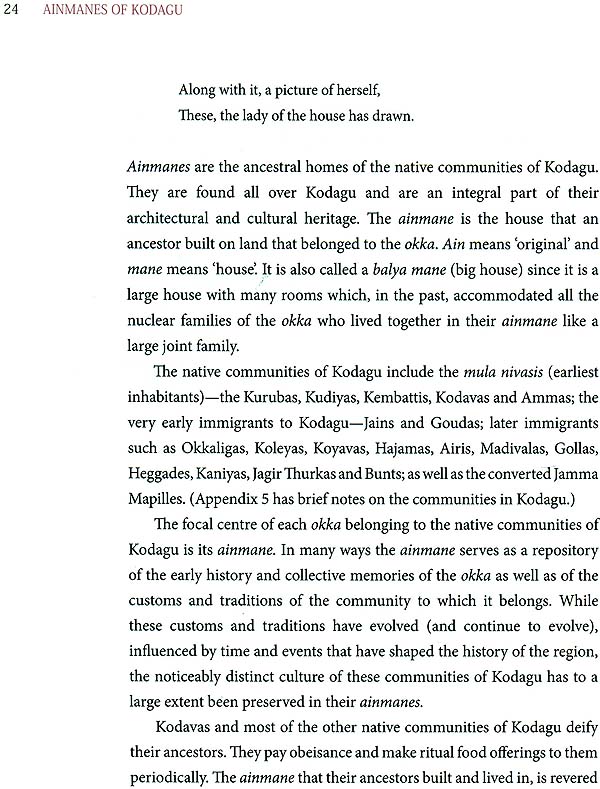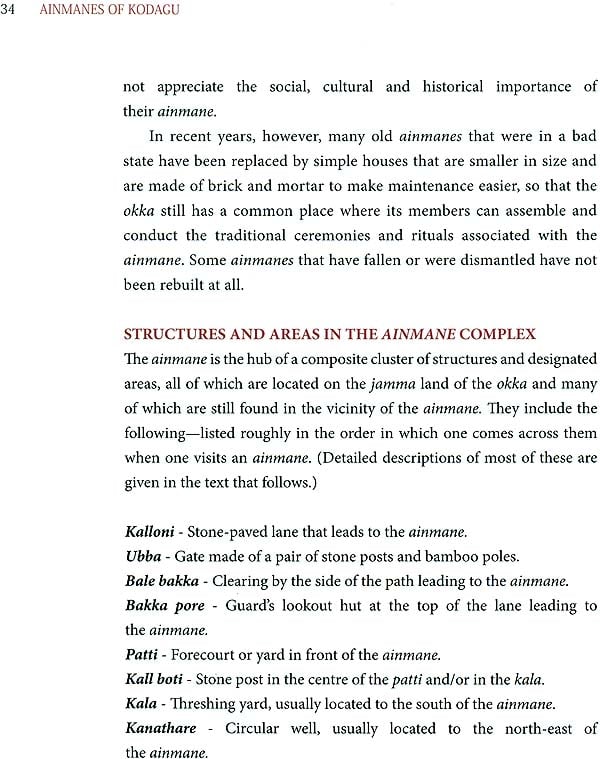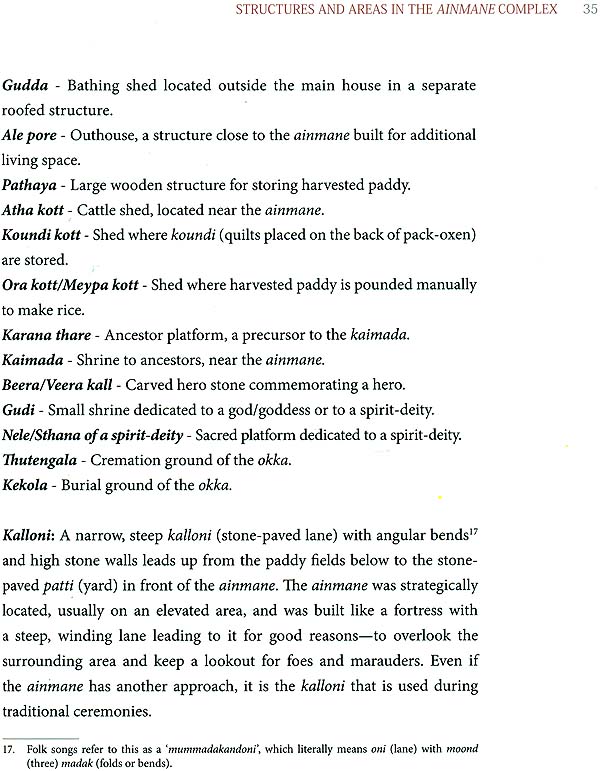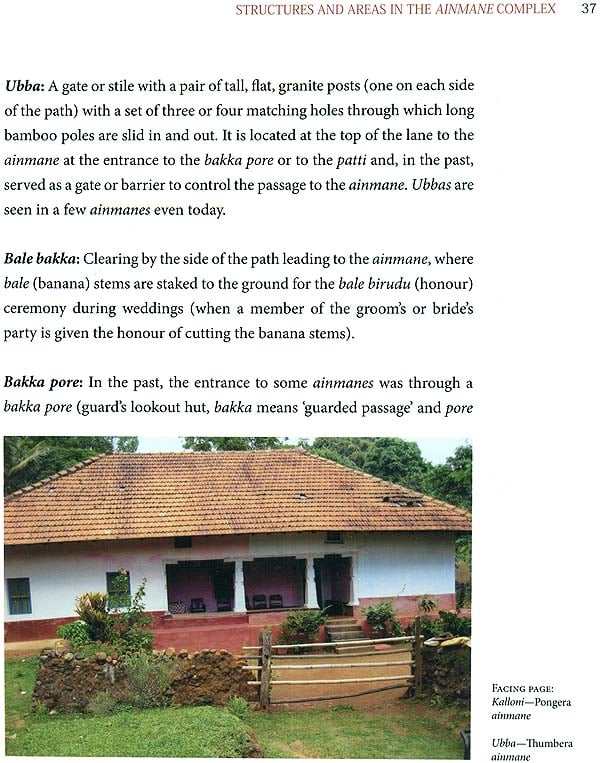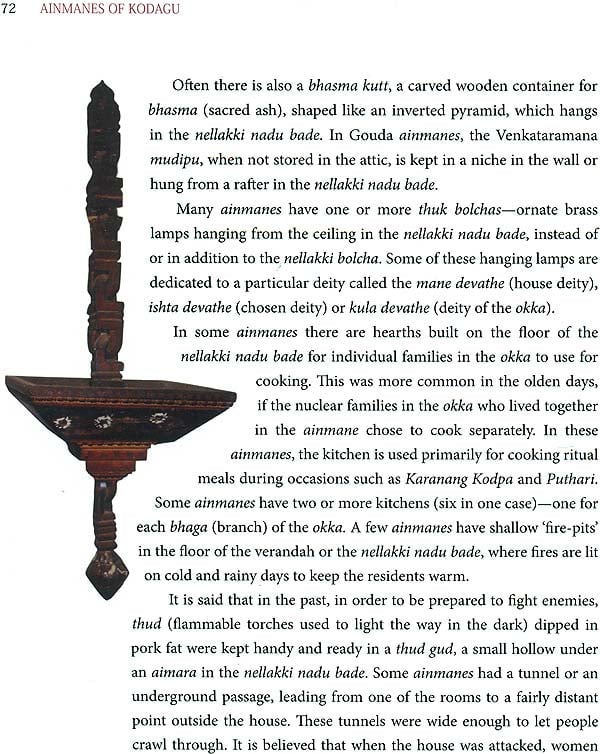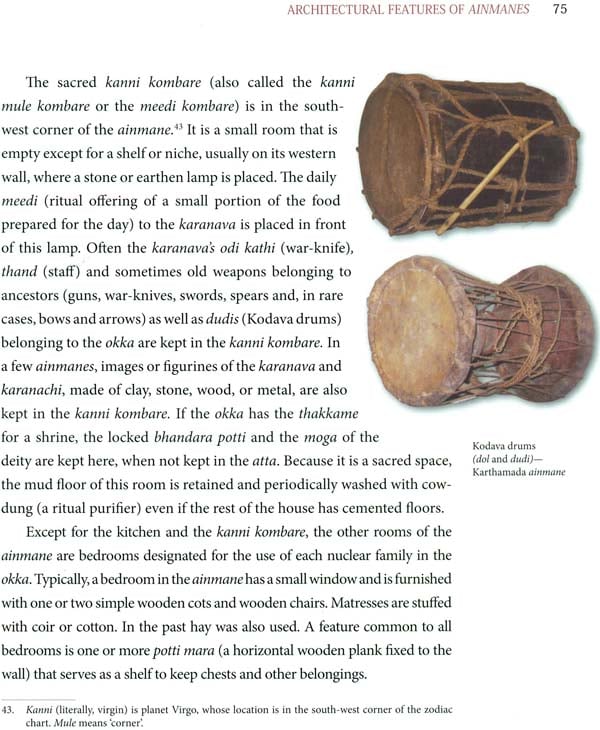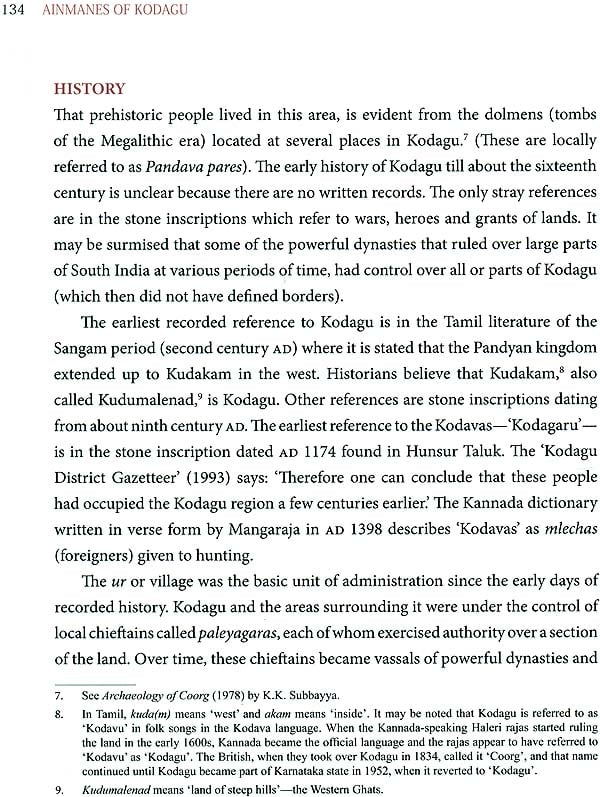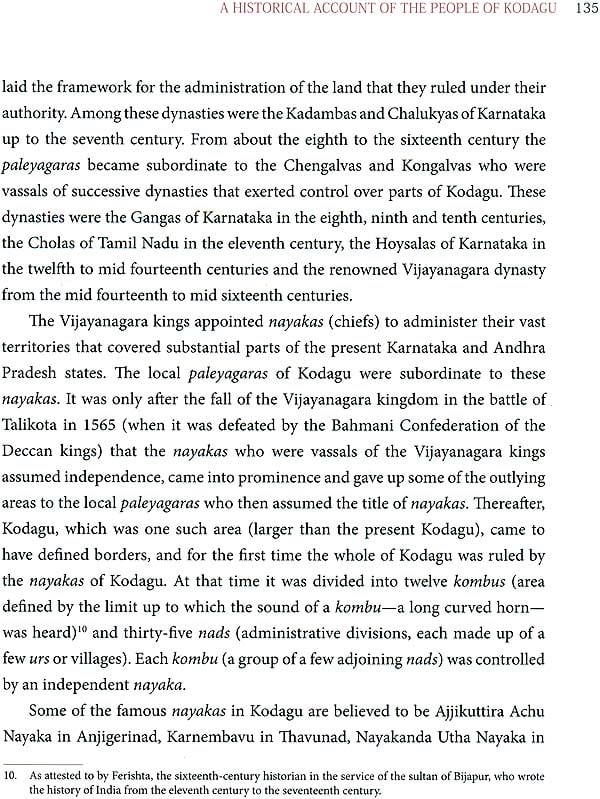
Ainmanes of Kodagu (Ancestral Homes of Kodagu and their Socio- Cultural Significance)
Book Specification
| Item Code: | NAL738 |
| Author: | Chinnappa Boverianda and Nanjamma |
| Publisher: | Niyogi Books |
| Language: | English |
| Edition: | 2014 |
| ISBN: | 9789383098439 |
| Pages: | 276 (Throughout Color Illustrations) |
| Cover: | Paperback |
| Other Details | 8.5 inch x 7.0 inch |
| Weight | 690 gm |
Book Description
Ainmanes of Kodagu describes the ainmanes (ancestral homes) of the native communities in Kodagu (Coorg) and their socio- cultural significance. Ainmanes are architectural symbols and expressions of the heritage and culture of the people living in this distinctive district of Karnataka state in South India. They bear testimony to the strength and vitality of the okkas (patrilineal clans) of Kodagu and their culture. These ainmanes and the traditions associated with them continue to play a significant role in the lives of the people of Kodagu to this day.
The focus of this book is the traditional ainmanes of Kodagu that are functional. A ‘functional’ ainmane is where all the members of the okka gather to celebrate important ceremonies.
The authors, Chinnappa Boverianda and Nanjamma, have written this book after extensive fieldwork to record for posterity the entire way of life that the ainmanes symbolize. The accompanying photographs, maps and floor plans help us understand and appreciate why animanes are unique to Kodagu and regarded as ‘heritage buildings’.
Equipped with a degree in Mechnical Engineering (Madras University) and masters in Industrial Engineering (Northwestern University, Illinois), Chinnappa has worked in India, Sweden, Germany and Canada in various positions including directorship and consultancy. Along with his wife, Nanjamma, he has translated into English the ‘ Pattole Palame’ by Nadikerianda Chinnappa (1924) which was written in Kannada (text) and Kodava language (songs, proverbs, etc). At present he is retired and lives in Baglore with his wife.
Nanjamma pursued a career in statistics in various capacities such as, Survey statistician and Director, Statistics Canada and statistical Consultant to national and international agencies. She has a masters degree in Statistics (Madras University) as well as one in Advanced statistics (Indian Statistical Institute, Calcutta), and has been a vising fellow at Cambridge University, UK. After her retirement, she, in collaboration with her husband, has dedicated herself to the cause of the preservation of the language, architecture and culture of the native communities of Kodagu.
This book is about the ainmanes (ancestral homes) of the native communities of Kodagu and about their socio-cultural significance. Ainmanes are architectural symbols and expressions of the heritage and culture of the people living in this rather remote and distinctive district of Karnataka state in South India. Each ainmane belongs to an okka (patrilineal clan) identified by its mane peda (house name). Ainmanes are unique to Kodagu and are regarded as 'heritage buildings: They bear testimony to the strength and vitality of the okkas of Kodagu and their culture. These ainmanes and the traditions associated with them continue to play a significant role in the lives of the people of Kodagu in this, the twenty-first century.
The focus of this book is the traditional ainmanes of Kodagu that are functional. A 'traditional' ainmane has a verandah in front with carved, square, wooden pillars and wooden seats between the pillars, carved windows and door frames, and specific areas within the ainmane for the performance of rituals. A 'functional' one is where all the members of the okka gather to celebrate important ceremonies.
The origin of the ainmanes dates back many centuries. While the earliest dwellings in Kodagu began as simple mud huts, the more elaborate traditional ainmanes that are unique to Kodagu evolved since about 500 years ago. In fact, just about all of these early traditional ainmanes except for a few are no longer there. Some were rebuilt in the same traditional style, some were rebuilt as simple houses, and some not at all. The ainmanes that are in the traditional style and are functional-the focus of this book-date from about 150 to 250 years ago.
We felt the need to preserve, at least in writing and in visuals, information on these ainmanes and on the customs and rituals that continue to be followed there, as a legacy for future generations and as a record of local history.
While planning this project to collect information on the ainmanes of Kodagu and present it in a book and in a website that complements the book, we decided to cover the ainmanes of all the communities in Kodagu. We knew that this would be a time-consuming effort and would need ample resources and help. We were fortunate on both counts.
We consider ourselves blessed to have experienced the beauty of our land and the generosity of its people during the fieldwork for this project which covered a period of five years, from April 2003 to May 2008.
The book starts with an introduction and moves on to describe the ainmanes of Kodagu, their history, evolution, and current status. The structures in the ainmane complex and the architectural features of the ainmane are given in detail, along with floor plans of typical ainmanes. The socio-cultural significance of the ainmane, the traditions associated with it and the ceremonies and festivals held in it are also described.
The appendices give some background information that sets the ainmane in its geographical, historical and social context. They include a note on how we went about the fieldwork for this project, and descriptions of the land, a historical account of the people of Kodagu, and the system of land tenure in Kodagu. Also included in the appendices is brief information on the communities living in Kodagu, the languages spoken by the native communities, their religious beliefs, some of their unique ceremonies and social conventions, their folk songs and folk dances-all of which provide a glimpse of the socio-culturallife of the native communities of Kodagu.
Sketch maps of Kodagu showing the location of each ainmane we visited are provided in the appendices. The ainmanes are identified by numbers on the maps, and an accompanying index for each map lists the corresponding okka names of the ainmanes. Sketches of floor plans of the two types of ainmanes are given in an appendix.
The appendices include summary tables showing the number of traditional ainmanes (visited), the number of non-traditional ainmanes, the number of okkas with no ainmanes, as well as the total number of okkas, by community. A time sequence of some important events in history is given in an appendix.
The information collected on each ainmane and okka, and photographs of the ainmane and of some of its interesting features are available in the website www.ainmanes.comthatcomplementsthisbook.This information can be retrieved by okka name, community name or village name.
As an illustration of the contents of the website, the information and photographs relating to two ainmanes are presented in an appendix.
All non-English words in the book are given in italics and are transliterated, but with no diacritical marks so as not to clutter the text. Diacritical marks for the transliterated words are given in the glossary. (Please see the note on transliteration and key to the transliteration on page 258.) The exceptions to this are proper names of persons and places where we have retained the conventional spellings.
The cultural heritage of a people is a priceless legacy passed down from generation to generation. It is experienced in the current generation in both tangible and intangible ways. The tangible aspects of a culture include the habitats of the people as well as the costumes and artifacts that they use in their daily lives and rituals. The intangible aspects include their traditions, customs, festivals, rituals, language, folklore, songs and dances. The tangible and intangible aspects of a culture are so closely knit together that neither of these aspects can be observed or experienced in isolation.
An important part of the tangible heritage of the native communities of Kodagu is their architectural heritage-their ainmanes or ancestral homes. Each ainrnane' belongs to an okka' (an exogamous patrilineal clan whose members claim descent from a common ancestor) which is identified by its distinctive mane peda (house or okka name). The mane peda identifies both the members of an okka and their ainmane. More details on mane pedas are given in Appendix 9.
The traditions, customs, festivals and rituals that are associated with the ainmanes are some of the intangible aspects of their unique culture and are an inalienable part of their heritage.
The ainmanes of many okkas are no longer there: some are in a state of disrepair or are in a dilapidated condition; and a few have in fact been rebuilt as simple houses. The traditional ainmanes that are still standing today account for only about forty per cent of the ainmanes that were built in Kodagu.
It was our decision to visit and document only those 'traditional' ainmanes that are 'functional'. A 'traditional' ainmane is characterised by a kayyale (verandah) in front with carved, square, tapered, wooden pillars, aimaras (wooden bench -seats) between the pillars, ornately carved wooden windows and door frames, and specific areas within the ainmane for the performance of rituals. A 'functional' one is where all the members of the okka gather to celebrate important festivals, ceremonies and rituals such as Karanang Kodpu' (ritual offerings to ancestors), Puthari (harvest festival) or Hari Seve (worship of God Venkataramana).
It is estimated that currently there are about 1500 (1750) okkas in Kodagu and the total number of traditional ainmanes that are still standing and are functional (as defined above) is around 680. Kodavas, the largest among the native communities of Kodagu, with nearly 900 (1050) okkas account for around 430 of these ainmanes. There are about 270 (320) Gouda okkas which account for around 130 of the 680 ainmanes. All the other native communities put together-about 330 (380) okkas-account for the remaining nearly 120 ainmanes. (The figures within brackets include branches within an okka that have separate ainmanes.)
In about eighty per cent of the okkas, the total number of members' in the okka ranges from about 15 to 150. A few okkas have many more members. While in the past all the members of an okka lived together in their ainmane under one roof, that is no longer so. Currently the number of members of an okka who live in their ainmane ranges from none to fifteen, except in a few cases.
If the original ainmane was renovated or rebuilt with its front exterior retaining the traditional design of the typical kayyale, and if the ainmane was functional, it has been included in this project.
It may be noted that some ainmanes, mainly those of the smaller communities, are small and simple compared to most of those of the larger communities.
In a few okkas a split in the okka has resulted in the total separation of the bhagas (branches) within the okka, with the breakaway bhagas building their own ainmanes on their portion of the jamma (ancestral) land or on land bought in a new location. Such an okka therefore has more than one ainmane, each belonging to a bhaga of the okka. If one of these ainmanes, invariably the original or the oldest among them, is considered the primary ainmane or arvad of the okka (where all the bhagas meet at least once a year for Karanang Kodpa, Puthari or Hari Seve), we have visited and documented only the arvad. However, if a breakaway bhaga has an ainmane built in the traditional style, conducts all the important ceremonies in its own ainmane and does not join the other bhagas in their arvad, its ainmane is considered as functional and has been included in this project. Thus where there are two or more functional ainmanes built in the traditional style belonging to bhagas within the same okka, we have included all of them.
In a few cases, bhagas that broke away from the original okka do not have ainmanes of their own and do not go to the original ainmane of that okka. In many of these cases there is not even 'familial' contact between the bhagas. However, it may be noted that in nearly all these cases, all the bhagas within the okka continue to use the original thutengala (cremation ground) or kekola (burial ground) of the okka.
In recent years, many old ainmanes that were in a state of disrepair have been rebuilt in brick and stone like simple modern houses. Although these houses might serve as the ainmanes of their okkas, they have not been included in this project because they are not in the traditional style. We hope that, at a later date, the second phase of this project will be undertaken-to collect information on okkas that have either rebuilt their ainmanes in a non-traditional style or do not have ainmanes now.
The description of the ainmanes of Kodagu, their evolution and their socio-cultural significance presented in this book is based on the picture that emerged when we analysed the information collected from the nearly 700 ainmanes that we visited. While there were individual divergences from the picture presented here (these divergences have been pointed out in the text), the overall impression is of a broad similarity in the physical features of the ainmanes all over Kodagu, and in the traditions, customs and rituals followed in them.
| Preface | 11 | |
| Introduction | 15 | |
| Ainmanes of Kodagu | 21 | |
| Evolution of the Ainmane | ||
| Structures and Areas in the Ainmane Complex | ||
| Architectural Features of Ainmanes | ||
| Socio-Cultural Significance of Ainmanes | 77 | |
| Traditions associated with the Ainmane | ||
| Ceremonies held in the Ainmane | ||
| Festivals celebrated in the Ainmane | ||
| Conclusion | 107 | |
| Epilogue | 111 | |
| Appendices | 115 | |
| 1 | Fieldwork | 117 |
| 2 | Kodagu-the Land | 124 |
| 3 | A Historical Account of the People of Kodagu | 128 |
| 4 | Land Tenure | 146 |
| 5 | Communities | 149 |
| 6 | Languages | 160 |
| 7 | Religious Practices | 162 |
| 8 | Nari Mangala | 171 |
| 9 | Mane Pedas | 173 |
| 10 | Thakkame | 178 |
| 11 | Folk Songs and Folk Dances | 181 |
| 12 | An Extract from a Mane Pat | 186 |
| 13 | Summary Tables of Ainmanes | 194 |
| 14 | Time Sequence of some Important Events in History | 198 |
| 15 | Maps | 200 |
| 16 | Sketches of Floor Plans of Typical Ainmanes | 236 |
| 17 | Information in the Website on Two Ainmanes | 238 |
| Select Bibliography | 254 | |
| Key to Transliteration | 258 | |
| Glossary | 259 | |
| Acknowledgements | 270 |
